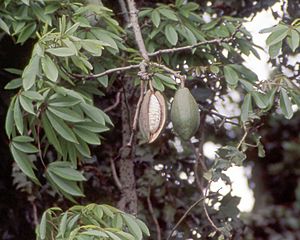Kapok facts for kids
Quick facts for kids Kapok |
|
|---|---|
 |
|
| Kapok planted in Honolulu, Hawaii | |
| Scientific classification | |
| Kingdom: | |
| Division: | |
| Class: | |
| Order: | |
| Family: | |
| Genus: | |
| Species: |
Ceiba pentandra
|
| Binomial name | |
| Ceiba pentandra |
|
The Kapok tree, also known as Ceiba pentandra, is a fascinating tropical tree. It belongs to the Malvaceae family, which also includes plants like cotton and hibiscus. This amazing tree is famous for the soft, fluffy fiber found inside its seed pods.
Kapok trees are often called Java cotton or Java kapok. They are also known simply as ceiba. For ancient civilizations like the Maya people, the Kapok tree was a very important and sacred symbol.
Contents
What is the Kapok Tree?
The Kapok tree is a giant of the plant world! It can grow incredibly tall, reaching heights of 60 to 70 meters (about 200 to 230 feet). That's as tall as a 20-story building! Its trunk is also very wide, sometimes up to 3 meters (10 feet) across. The base of the trunk often has large, flat supports called buttresses. These help the tree stay stable.
Where Does the Kapok Tree Grow?
Kapok trees are native to warm, tropical parts of the world. You can find them growing naturally in Mexico, Central America, and the Caribbean islands. They also thrive in northern South America. A special type of Kapok tree, called Ceiba pentandra var. guineensis, grows in tropical West Africa.
What Does the Kapok Tree Look Like?
Besides its impressive height and wide trunk, the Kapok tree has beautiful flowers. These flowers are usually white or pink. It takes about four weeks for a flower bud to grow and open. After the flowers, the tree produces large seed pods. These pods are where the famous kapok fiber is found.
The Amazing Kapok Fiber
The word "kapok" is also used for the soft, cotton-like fiber that comes from the tree's seed pods. This fiber is very light and fluffy. It's also naturally buoyant, meaning it floats on water. Because of these qualities, kapok fiber has been used for many different things. People have used it to stuff pillows, mattresses, and life jackets. It's a natural and sustainable material.
Kapok in Culture and History
For the ancient Maya people, the Kapok tree was more than just a plant. It was considered a sacred "tree of life." They believed its branches reached into the heavens, its trunk connected to the Earth, and its roots went deep into the underworld. This made the Kapok tree a central part of their spiritual beliefs and stories.


